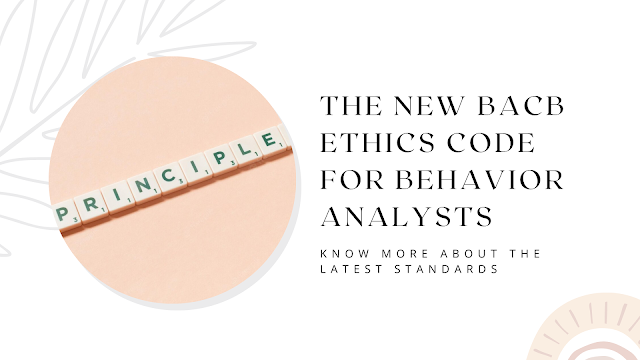The New BACB Ethics Code For Behavior Analysts
The BACB Ethics Code, formerly known as the “Model Code of Ethical Behavior for Behavior Analytic Practitioners,” was initially created to provide behavioral health professionals with an ethical path for working with individuals suffering from mental illness. Since its creation in 1986, the BACB Ethics Code has been revised to include many other areas that relate to human services and treatment. The most recent changes are due to increased oversight by the Department of Health and Human Services and the new “Ethics Code for Behavioral Health Services” set forth by the American Psychological Association (APA), which drew inspiration from the BACB Ethics Code.
The Core Principles to keep in Mind:
A foundation of ethical behavior is key to the success of behavior analysts in their career. The first principle in the code is a fitting introduction as it emphasizes how behavior analysts should treat others with compassion and dignity, while also being considerate and respectful. This principle has been a long-standing staple of applied psychology but has recently gained traction in business settings as well. The additional principles help behavior analysts take care of their own health and well-being, do not engage in questionable or illegal activities, and always endeavor to maintain the integrity of the profession.
Understanding the Code:
Although presenting a simple statement in the new code, this is actually not a new concept to ethical decision-making in the field of behavior analysis or influence. The human factors movement has long advocated for developing “the letter and spirit” of a code as part of an overall ethical framework. This makes sense because many ethical issues stem from a lack of both balance between forces (such as rules vs. principles) and proper understanding of the ethical concepts themselves.
When a client provides a gift to the behavior analyst, it is generally accepted as a "token of appreciation." However, this is not always the case in the current code. The purpose of these codes is to prevent favoritism between client and behavior analyst by restricting gifts that may be perceived as bribery by third parties. But what if a client provides an additional monetary value to the behavior analyst that exceeds what was originally agreed upon? In this instance, there would be an example of one-sided gratitude and favoritism -- which violates the spirit of the code.
Structure & Content Navigation:
The new code includes a glossary of terms which has been placed in front of the document rather than at the end. Using this new method, the glossary is easily accessible and user friendly to those unfamiliar with the organization or technology standards being discussed. This new approach allows for quick referencing when reading through each chapter of the code. The old glossary was not easily read by non-professional users due to its placement near the end of the document, however the new glossary provides immediate access to definitions and related terms.
Whats new in the Menu?
The new code has changed some of the definitions of words you may have encountered in previous versions. Assent is a new term in the glossary, but it is not a new term in the behavior analysis community. Assent is defined as, “Vocal or nonvocal verbal behavior that can be taken to indicate willingness to participate in research or behavioral services by individuals who cannot provide informed consent (e.g., because of age or intellectual impairments).” (pg. 7) It is encouraging to see this small move towards respecting all forms of communication and self-advocacy, regardless of age and abilities.
New standards for Cultural/diversity Awareness:
The American Humane Association created a new code of conduct for behavioral health professionals regarding diversity and cultural awareness. The new code incorporates topics such as incorporating diversity in training, professional development, and supervision; taking responsibility for the profession's treatment of other cultures; addressing implicit bias and covert bias in the profession; understanding cultural differences in service delivery; and reflecting on the effects of cross-cultural experiences during assessment and treatment.
Conclusion:
Despite the positive changes brought by the new code of ethics, there will still be areas for improvement in the coming years. The BA community should continue promoting progressive and ethical values to society at large. Additionally, behavior analysts should be aware of their responsibilities under the new code, and take necessary steps to remedy any past harm.
If your looking to learn more about the New Ethics Code, click the links below:
Ethics Code for Behavior Analysts - 2022
Are you looking for a ABA Practice Management software to ease the stress that comes with running your own ABA practice?
AlohaABA is a cloud based Practice management software, designed to help ABA practitioners. With features like Billing, Payroll, Scheduling, tracking Account receivables & Top tier customer support, AlohaABA is an all-in-one solution for ABA practitioners.
Click the link to Sign up for a Demo or drop us a mail at info@alohaaba.com


Comments
Post a Comment